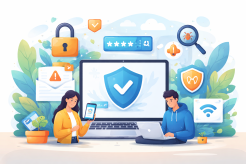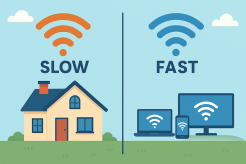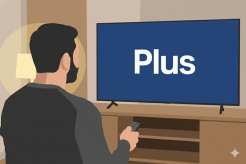Always Check the Website You Visit

The Internet offers us an ocean of possibilities for knowledge, amusement and correspondence. But the good most certainly comes with some evil, as with anything in life. And the bad can be really bad when it comes to the internet.
Hackers, scammers, and other cyber criminals might be hiding under the scenes, waiting for you to make a mistake and do the wrong thing, or even worse, to deceive you into trusting them with confidential information, such as bank account numbers or credit card numbers, which they will then use to steal from you and cause you all sorts of problems.
An Anti-virus software and other cyber security services make it much easier for you to stay safe online. Though, at the end of the day, your digital security relies on you and your ability to identify a threat before it becomes more serious and leaves you struggling to recover from identity theft.
How to tell the difference between secure and legitimate sites and malicious websites that can cause you real problems is one of the skills you need to learn to make sure you stay safe online.
Knowing the Threat
To explain why learning how to recognise and avoid bad websites is relevant, here are some figures on the threats we face when we go online:
1: Double check the URL
There are several various ways you can tell if the website is safe and secure, but perhaps one of the easiest and most obvious is to check the URL of the site to see if it meets the security standards that we now have for legitimate sites.
Here is a list of the things you should be searching for:
Is this the site you looking for
Almost all of us end up on websites because we either click on links found on other sites or sent to us via social media and email. That's great, just make sure that the place you're visiting is really the site you've planned to visit.
You need to start before going to the site in question for this to work. Inspect the URL associated with the reference that you would like to follow. By using your mouse to fly over the hyperlinked message, you can do this. The reference page will take you to display on the bottom-left of your browser window whether you click on it. Look for the URL that fits the page that the reference leads to you. If it's not, it's a clear red flag.
When you feel good about how the reference looks and choose to click on it, the next move is to ensure that the actual URL of the page you landed on is the same as the one you wanted to click on.
Look very closely when doing this, even if the page looks exactly as you expected it to look like. Scammers are very skilled at making pages with slightly different URLs that look exactly like the real thing. It's easy to fool the untrained eye. The www.amazon.com, for example, could be written as www.amazoon.com. If the page looks exactly like it should, you may not see the difference.
As a consequence, make sure you check the site's URL double and triple before doing anything on it. It will save you from clicking on links for a bad page, something that can contribute to serious down the road issues.
URL should start with https
Since before the 1990s, when Tim Berners-Lee developed the idea of the World Wide Web and plugins, the Internet has been working on hypertext transfer protocol (HTTP). Since then, not much has changed except that most sites now use HTTPS, with the "s" being encrypted.
This method was first used by banking and eCommerce platforms because they often collect bank and credit card data from individuals.
In fact, the platform encrypts the data inserted into it with HTTPS, adding an extra layer of security and making it much more impossible for your personal information to fall into the wrong hands.
Nearly every page today uses HTTPS, mostly because Google and other search engines include it in their ranking algorithms (they want to make sure that the pages they submit to users are safe). As a consequence, if you are sent to a page not using HTTPS, it should be a big red flag that something is up. Well, if you don't have HTTPS, you definitely should be steering clear.
And see if the website has HTTPS, simply look at your browser's URL bar. To signify that the page is safe, there should be either a lock or some other icon or it might even say "secure."
Of course, even when a website has HTTPS doesn't immediately mean it's safe and legitimate. Bad websites also can have this security protocol, particularly if they're trying to look legitimate, but it's still a good place to start.
Use URL Checkers
One approach you can do to make sure that the URL of the page you are accessing is legitimate is to insert it into a URL checker. Such services can be used free of charge remotely and will run a test on the URL in question to see if there were any issues with it before.
If the tool shows any results this can be a lifesaver. This will tell you that people on the web have encountered identity theft, or have gone away with a virus so naturally that should be enough to deter you from moving on. On the opposite, if a page has deemed safe and reliable, these resources will also tell you that you can go to the URL with much more detail.
Of course, the drawback to these devices is that if there are no details about the site in question, they won't tell you much. Because of this, don't say that the page is legitimate because of no tests. Then, consider it for what it is: a warning that until you get there you won't know what's on the page. It may be all right, but browse the threats and be able to respond should you notice anything unusual when you get there.
2: Look for the Content
Once you're convinced the URL is okay, it's safe to proceed to the website. However, just
When you are confident that the URL is all right, going to the website is free. Just because the URL looks all right, though, it does not mean that the site is safe and secure. As a consequence, if you're uncertain about the page, spend some time exploring the content to see if you can find out more about what you're doing.
Here are few things to look for:
Check the Comments/Reviews
Look through some of the website's written content, like the About Us section and the blog. You're looking to see if the content seems to have been generated by humans when you do this. Usually you can say on the basis of how it looks. Artificial intelligence is good, but when a site relies too much on it for content creation, you can typically spot it.
Bogus websites are trying to do this because they want to give the illusion of legitimacy. We want you to feel at ease enough on the web to start pressing around and eventually land on whatever the bad guys have installed on your machine to either install malicious software or, worse, rob from you.
If you're not confident, check at the site's posts. If they too appear to be programmed, this is a warning that the page does not really interact. This could claim it has thousands and thousands of subscribers, but if those engaging with material leave generic comments in broken English that were clearly written by a bad computer program, then the page is probably not real and should be avoided.
Ads and Redirects
When you're unaware of the credibility of a page, what's going on the page while you're walking around is a helpful thing to look through. Clicking on some parts of the site, for instance, allows irritating pop-up ads to appear? Or is it opening new garbage tabs or windows? Those strategies are intended to get you to mistakenly click on something.
This is where, you might get a pop-up message saying your computer has been infected and you need to download an "anti-virus software" right away.
Most of the pop-ups at the top of the window may even have fake x's that appear like the way to close the pop-up, but in fact they are just leads to more pop-ups! If you're not patient, it can be a never-ending cycle.
Redirects are another thing to look for. This happens when you click on a link that takes you to another site that is not the one that you intend to visit. For sites run by especially experienced cyber criminals, these other pages that look just like the one you wanted to open, so make sure you check the URL before continuing.
But, in fact, by spending only a few minutes on it, you will be able to tell if a page is potentially bad. Clean, secure, legal pages have no insane pop-up ads and redirects out of reach.
3: Double check the Reputation of the website
You should have a good idea as to whether or not the page is genuine after you have had a chance to check out the URL and the content.
The very first thing you need to do is just google it. Specify anything like "Is (website) safe?" or "scams linked to X website." Something related to this would do, but just make sure you type it into Google and not the URL bar, because it could take you to the actual website, and if it is problematic, you would be in serious trouble.
See if it comes up in any scam-related stories or posts when you do this. First, spend some time reading web reviews Whether the site is a full-on scam, it is possible that there will be several others out there who have fallen victim to the site and reported it.
It is a particularly clever thing to do when you're on an eCommerce page that doesn't inspire confidence in you. Read up to see what other people's experiences had to do with the business. You might have had no issues whatsoever, which would be great news for you. And if someone gets ripped off, they're sure to write somewhere about it, which will probably save you from experiencing a fate identical to those before you.
You can also search the Better Business Bureau to see if any complaints against the company you are dealing with have been filed.
4: Look for Contact Information
Look for the contact information on the site as a kind of last-ditch effort. Sites don't have telephone numbers or don't mention their username, but they should have an email address or a contact form that you can fill up.
Reach the site before making a purchase or disclosing any personal information. If the page is genuine, after sending a message, you should get a response pretty quickly. But if the page is not secure, then either the email will not move or it will remain unanswered. If this happens, be glad that you managed to get in touch with someone before you could ruin it.
Even when the site lists a phone number, try to see if it is real as well. The number will almost certainly not work for spammy sites that are not safe. If there is no contact information at all, take it as a sign that the site is not safe.
Understanding how to identify a dangerous website before it causes you harm is a vital way of staying secure when browsing the internet, but it's not the only thing you should do to stay safe from the various threats you may face online.
Here are some additional things you can do to help you stay safe online:
The browser has a range of tools that you can use to help make it less likely that you will inadvertently end up on an insecure page. To activate them, you need to go to the settings menu of your app, select "Basic" or "Enhanced Configuration" and then click the security options.
Other things you can do involve blocking advertisements and other pop-ups, limiting possibly harmful Flash content, sending Do Not Track requests to keep your web page secret and secure, as well as limiting access to your camera, webcam, mobile phone, etc.
Since you are worried about wandering on a bad site or just want to ensure that your private information is as protected as possible, make sure that the security settings of your browser are set to the highest possible level.
Anti-Virus Software
You're going to want to make sure you have some kind of anti-virus software on your device to help keep you safe from what's out there. Anti-virus software is beneficial as it creates a different level of protection between you and the potentially harmful web content.
It will block files from instantly uploading to your device without your permission, which can be extremely helpful if you wind up on a site with loads of pop-up ads which redirects, and will also make it easier to quarantine corrupted files and delete them until they wreak havoc on the rest of your network.
One advantage of anti-virus software is that it often comes with a browser extension that makes it much easier for you to decide whether or not a page is legitimate. Whether it is or not, it will tell you right on the monitor, and while you can always bypass it and access the site if you really want, it's a great defense against fake websites that can hurt you.
Ultimately, to stay safe online, it's crucial to follow healthy browsing habits, and there's no better way to do that than using a "when in doubt, don't press" approach to using the web.
Generally, you can say where, at least, something seems strange, and when you get the impression, listen to your intuition and run away. Eventually, figuring out that the page is ok due to some additional research is much easier than learning the hard way it is not secure.
This strategy will also make it easier for you to stop email scams and other attempts to remove your private information from you and use it to steal it from you. If you can learn how to do this when deciding which sites to visit are safe, you will take a big step towards avoiding all the different things that cyber criminals can do to those who are not well versed in online sec.
Related Posts

Thu, Dec 18, 2025 3:59 AM
cheap internet dealsViasat (Exede) Satellite Internet Plans & Pricings
Explore Viasat (Exede) satellite internet plans, pricing, and speeds. Learn about availability, equipment, technology, and tips for rural and remote areas.

Thu, Dec 18, 2025 2:14 AM
SafetySimple Online Safety Tips Anyone Can Follow
Learn simple, practical ways to stay safe online—even if you’re not tech-savvy. Protect your data, avoid scams, and improve digital security with easy habits.

Wed, Dec 17, 2025 2:22 AM
WifiWhy’s My Internet Slower Than What I’m Paying For?
Paying for fast internet but getting slow speeds? Learn the real reasons your internet doesn’t match your plan and how to fix performance issues.

Wed, Dec 17, 2025 1:55 AM
TechnologyDisney Plus: Shows, Plans & Must-Watch Picks
Discover Disney Plus features, subscription plans, and what to watch. Learn why Disney Plus is worth it for families, Marvel fans, and Star Wars enthusiasts.

Tue, Dec 16, 2025 2:05 AM
Internet BundlesBest Home Wi‑Fi and Internet Providers in the U.S. (Updated)
Compare the best home Wi‑Fi and internet providers in the U.S., including up‑to‑date pricing, speeds, and coverage for Xfinity, Verizon Fios, AT&T Fiber, CenturyLink, and satellite options.